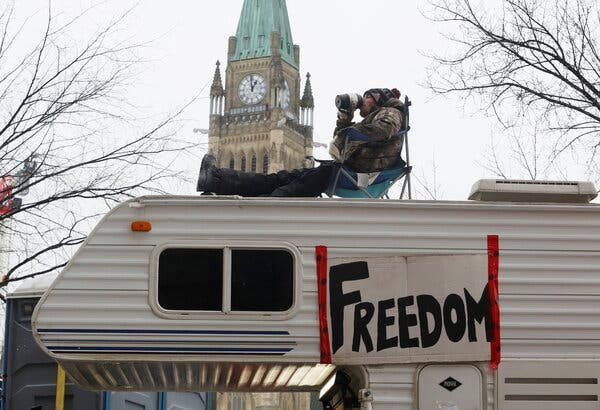
Canadians awoke on Monday with their capital, Ottawa, under a state of emergency.
On Sunday afternoon, the mayor of Ottawa declared the emergency after more than a week of unrest that began with protests by truckers over vaccine mandates. The protests have since mushroomed into an occupation of Canada’s capital and broader demonstrations over pandemic restrictions that have spread well beyond the capital.
Thousands turned out to protest in Toronto and Quebec City. Truck convoys congregated near provincial legislatures in Alberta, Saskatchewan, Manitoba and British Columbia.
The demonstrations snarled traffic and disrupted business and residential neighborhoods. Downtown Ottawa, site of the country’s Parliament, was paralyzed as truckers parked their vehicles in intersections and across busy thoroughfares.
“Someone is going to get killed or seriously injured because of the irresponsible behavior of some of these people,” Jim Watson, Ottawa’s mayor, warned on Sunday. City officials and the chief of police said they were under “siege.”
Early Monday morning in Ottawa, it was 14 degrees Fahrenheit and sunny, and the thousands of weekend protesters were gone. The streets near Parliament were quiet without the honking horns of the weekend. But trucks still clogged the roads heading to Parliament Hill, and with a snowfall overnight, had become part of the snow scape. Most had license plates from Ontario or Quebec, with a few from Alberta, in the west of the country. Many were decorated with Canadian flags. Several bore anti-Covid restriction posters and signs.
Late Sunday night, heavily armed police seized a tanker truck with more than 3,000 liters of diesel fuel from a staging area used by the truckers, and arrested people in downtown Ottawa for transporting fuel.
Near Parliament, one of the protesters said the group was prepared in the event the police seized more diesel fuel or if their trucks were towed.
“We have people working on things,” said Eric, a demonstrator from the Niagara region of Ontario who declined to give his full name. He was in a large delivery truck with a poppy painted on the side.
“What we are doing is within the law,” Eric said, adding that he could not say specifically what he wanted from Prime Minister Justin Trudeau, but that he needed to be “a man of the people.”
Throughout the pandemic, Canadians have been living under varying restrictions to combat the coronavirus. Although polls show that most Canadians support the measures, the protests are an expression of frustrations as the pandemic enters its third year.
The demonstrations were initially set off by Mr. Trudeau’s decision to require Covid vaccinations for truckers returning from the United States, mirroring a requirement imposed by the U.S. government for Canadian truckers crossing the border. In January, a convoy of trucks began traveling from British Columbia with protesters intending to pressure the prime minister to reverse the mandate.
As the convoy rolled along, it was joined and ultimately outnumbered by supporters traveling in pickup trucks and cars. The group — loosely organized and without a single, clear leader — also expanded its demands, pressing Mr. Trudeau to end all Covid rules and restrictions in Canada, including those set by provinces and local governments.
Long before the first trucks began trickling into Ottawa on Jan. 28, Mr. Trudeau said he would not reverse the vaccine mandate. He has refused to meet with members of the groups, which he described as a “fringe minority.”
On Jan. 29, the crowd around the Parliament Building in Ottawa swelled to more than 8,000 protesters and hundreds of trucks, by police estimates. As a security precaution, the Royal Canadian Mounted Police removed Mr. Trudeau and his family from the prime minister’s official residence. They are now staying in the prime minister’s official country residence outside Ottawa, where Mr. Trudeau is isolating because he has tested positive for the coronavirus.




